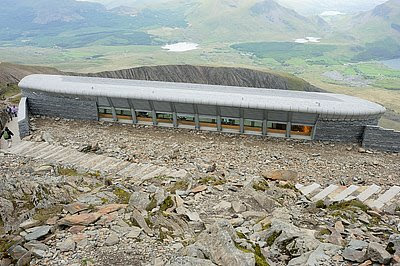
Photo of Hafod Eryri, the Welsh name for the building, from Snowdon Summit Blog
Slate quarrying was long Wales’ claim to fame and one of the most important industries in the country. Welsh slate was shipped around the world for use as gravestones, school slates, and most famously, for roofing. The men of the Welsh slate industry also traveled far. Poor working conditions, poor pay, strikes, and food shortages led to an exodus of Welsh workers to America in the 1840s. Their arrival jump started the nascent American slate industry and within a handful of years, slate from Pennsylvania, New York, Vermont, and Maine became the plastic of its day, a nearly ubiquitous material in the building trade.
Oddly, however, instead of using the 400-million-year old slate found on the sides of Snowdon, builders of the new structure imported their slate from Portugal. (Local granite, however, does clad the building.) I am sure that money was an issue but it seems odd to me that it wasn’t possible to find enough local slate to cover the roof of the building. Couldn’t the builders have simply gone around to abandoned quarries and just picked up some left over blocks of slate and made new roofing?
Stone has long been sent willy-nilly around the globe and as someone obsessed with seeing the wonderful stone used in the building trade, I shouldn’t complain, but sometimes I wonder if someone shouldn’t start a local stone movement, at least in a place such as Wales, where slate defined the country for centuries. I can see the taglines now: “Prevent the Reuniting of Gondwanaland; Don’t Ship Stone.” “Support Slow Stone; Use Only Regional Rock.” Okay, maybe I am living in a dream but I do think that in this world where we are trying to be more environmentally hip, that people should consider the global footprint of the stone they use. It can’t hurt to try.
I've been visiting so local sandstone quarries (which I've blogged about here)and the feedback I'm getting from the operators is that times are tough for UK quarries with planning regulations and government taxes making them uncompetitive against cheap imported stone. They partially blame architects who they accuse of picking stone from a pattern book or on price, with very little thought of heritage or 'stone miles'.
Here I was thinking what a crank I am for having such thoughts. My computer and I are in a house built on the Fordham gneiss, but a couple hundred feet from me is a marble quarry (Tuckahoe marble? I'm not sure). Many houses in the area are made from this wonderful lovely marble.
But I am really fried when I read articles about Westchester County mansions whose owners boast that they brought in marble from, say, seven different quarries in Italy. Bringing marble from Italy to the Hudson Valley? That should be a no-brainer. Nobody who does that is green, no matter what else they do. If you simply must have pink, there's pink granite in New Jersey!